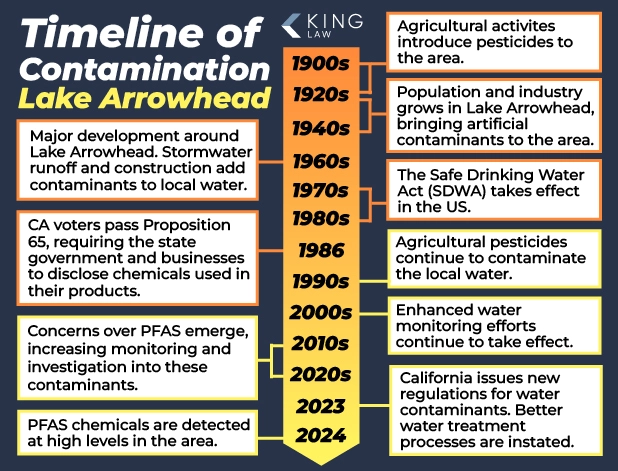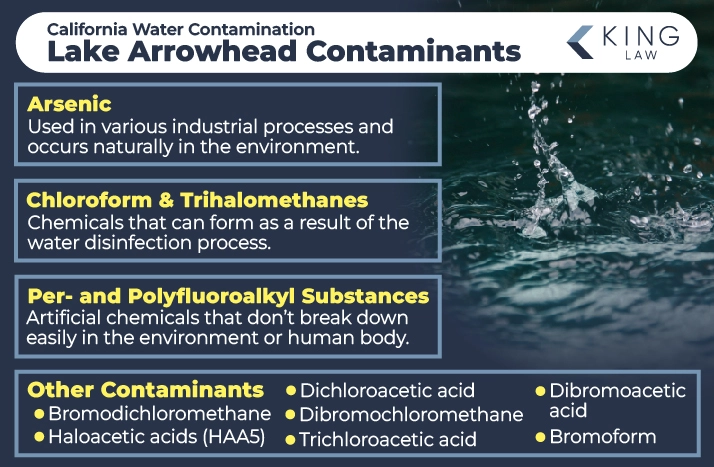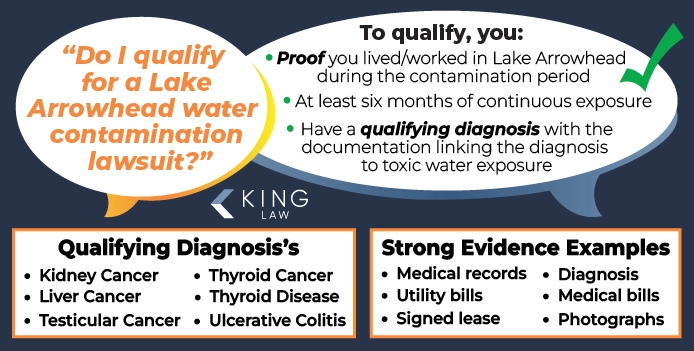
Commonly called “forever chemicals,” per- and polyfluoroalkyl substances (PFAS) are potentially dangerous substances linked to severe health problems. Exposure to PFAS may increase your risk of kidney cancer, liver cancer, testicular cancer, thyroid disease, ulcerative colitis, and more. Concerningly, PFAS substances have appeared in Lake Arrowhead, California’s water supply. The presence of these chemicals has caused worries about the quality and safety of the area’s drinking water.
Many locals who have been exposed to PFAS and other chemicals in Lake Arrowhead’s water have filed water contamination lawsuits. These cases target manufacturers and seek compensation for harm consumers may have sustained.
Lake Arrowhead Water Contamination Lawsuit Overview
Lake Arrowhead, California — known as Little Bear Lake until the 1920s — has built an economy linked to the tourist industry. The area’s scenic beauty draws thousands of visitors annually and offers ample recreational opportunities.
Despite the appeal, concerns about Lake Arrowhead’s water have dogged the area for many years. For example, pesticide usage from the area’s agriculture has allowed contaminants to invade the local environment. Moreover, contaminants from industry, construction, and vehicles can seep into the water, too. Illegal dumping and littering have also caused considerable environmental harm, despite attempts at remediation. Contaminants from these activities pose considerable health risks to consumers even in 2024. Many of those affected by PFAS are seeking compensation for their losses with the help of King Law.
Lake Arrowhead Water Contamination Lawsuit Updates
- 1900s – 1920s: The population of Lake Arrowhead and the surrounding area remains small. Agricultural activities begin to introduce pesticides to the area.
- 1920s – 1940s: Population growth and an industrial boom begin in southern California. This time of growth brings artificial contaminants to the area.
- 1960s: Major development begins around Lake Arrowhead. Construction and stormwater runoff that added contaminants to the local water.
- 1970s – 1980s: The Safe Drinking Water Act (SDWA) takes effect. Other state and federal regulations seek to control water pollution from various sources.
- 1986: California voters pass Proposition 65. The act requires the state government and businesses to disclose when products contain chemicals that may cause cancer, birth defects, and other harm. The regulations extend to drinking water.
- 1990s: Ongoing pesticide contamination from local agriculture raises concerns about local water quality.
- 2000s: Enhanced water monitoring efforts continue to take effect.
- 2010s – 2020s: Concerns over PFAS chemicals begin to emerge in California. State and local government initiatives begin to further investigate and monitor these contaminants.
- 2023: The State of California issues new regulations for contaminants like PFAS. Lake Arrowhead and other municipalities begin enhanced water treatment to combat these substances.
- 2024: High levels of PFAS chemicals are detected in the Lake Arrowhead area.

About Lake Arrowhead, California Water Contamination:
History of Water Contamination in Lake Arrowhead, California
Sources of Water Contamination in Lake Arrowhead
Lake Arrowhead, California Water Contamination Map
Lake Arrowhead, California Drinking Water Contaminants
Current Water Quality in Lake Arrowhead, California
Health Risks Linked to Drinking Water in Lake Arrowhead
Eligibility Criteria for the Lake Arrowhead Water Contamination Lawsuit
Lake Arrowhead Water Contamination Settlement and Payout Amounts
How to File a Lake Arrowhead, California Water Contamination Lawsuit
Statute of Limitations for Lake Arrowhead Water Contamination Claims
History of Water Contamination in Lake Arrowhead
The area around Lake Arrowhead only began to experience population growth after the 1920s. At the time, developers wanted to build a resort outside of the rapidly industrializing Los Angeles County. Over the years, the area became extremely popular with tourists and businesspeople. The region supported agriculture, hospitality services, and a variety of seasonal and year-round businesses.
However, the growth of agriculture, industry, and tourism, began to introduce higher levels of contaminants to the area’s water. Pesticides from farming, runoff from construction, improper disposal of waste, and other factors, all contributed to the problem. The rise of PFAS chemicals — which can last in both the body and the environment for exceptionally long periods — added a new level of concern for consumers of local water. As a result, the State of California and local water authorities have taken steps to reduce the risk of PFAS contamination to Lake Arrowhead residents. However, the risk of exposure will likely remain a long-term concern for the area.
Sources of Water Contamination in Lake Arrowhead
Various contaminants have impacted Lake Arrowhead and the surrounding area’s water. Even before large-scale development, naturally occurring toxic contaminants could pollute the water supply. For example, stormwater runoff caused by the area’s logging industry could easily introduce chemicals to the water. However, as development accelerated, more potentially harmful substances began to enter the water.
Agricultural enterprises also brought chemical fertilizers and pesticides to the area. These often contained harmful substances which could seep into the water supply. Improper waste management, illegal dumping, and recreational activities all added their fair share of contaminants, too. On the one hand, stricter regulations and a focus on environmental protection have helped ensure safer, cleaner water. However, long-term concerns about contamination remain.
Lake Arrowhead Water Contamination Map
Water contaminants, including PFAS chemicals, continue to affect Lake Arrowhead’s water supply. This water contamination map shows various sites of pollution affecting the area.
Contaminants Found in Lake Arrowhead Drinking Water
Lake Arrowhead’s drinking water has tested positive for various contaminants including PFAS. Some of these contaminants fall within federally mandated limits. However, many contaminant levels still exceed the safety recommendations of the Environmental Working Group’s (EWG’s) Health Guide.
Arsenic
While arsenic is a naturally occurring mineral, it is also a known carcinogen and poison. It can enter the water supply naturally, but agriculture and industry can also be contributing factors. Besides death, arsenic may pose a significant risk of various cancers (e.g., skin, bladder, and lung cancer), diabetes, skin disorders, and cardiovascular disease. Arsenic has been found in Lake Arrowhead’s water at a level at least 25 times higher than the EWG’s health guide.
Chloroform
When chlorine — which is commonly used in the water disinfection process — interacts with natural substances and decaying matter, chloroform may form. Exposure to unsafe levels of chloroform has its risks. Chloroform may increase your risk of cancer, kidney damage, liver problems, and nervous system damage. It may also cause problems with pregnancies and result in birth defects. Chloroform has been detected at levels 65 times higher than the EWG’s health guide.
Per- and poly-fluoroalkyl substances (PFAS)
PFAS chemicals have been used for years in various consumer products, from nonstick cookware to firefighting foam. PFAS chemicals can remain in the environment (and the human body) for very long periods. Even low levels of exposure can put individuals at risk of various cancers, thyroid disease, weakened childhood immune systems, ulcerative colitis, and other problems. Testing on Lake Arrowhead-area water has found levels of PFAS substances above proposed safety limits. For example, the chemical PFOA has been detected in water samples at levels of 8.7 – 14.0 ppt. However, the recommended safe level of the chemical is 4.0 ppt or less.
Trihalomethanes (THMs)
When chlorine and other contaminants are used in the water treatment process, various contaminants can form. These contaminants — which include chloroform — are called THMs. They were detected in Lake Arrowhead’s water at a total level nearly 340 times higher than the EWG’s safe consumption recommendations. Myriad THMs may put consumers at risk of various health issues. These include multiple types of cancer, problems with pregnancy, birth defects, neurological problems, and lung issues.
Other Contaminants
Various other contaminants have been found in Lake Arrowhead’s drinking water. Each presents potential health risks:
- Bromodichloromethane: Bladder cancer and other cancers, fetal development problems
- Bromoform: Bladder cancer and other cancers, fetal development problems
- Dibromoacetic acid: Cancer, problems with pregnancy
- Dibromochloromethane: Cancer, problems with pregnancy
- Dichloroacetic acid: Cancer, problems with pregnancy
- Haloacetic acids (HAA5): Cancer, harm to pregnancy
- Trichloroacetic acid: Bladder cancer, skin cancer, harm to fetal development

Current Water Quality in Lake Arrowhead
Lake Arrowhead, California’s water quality meets all federal water safety standards. However, many of these standards are quite old and have not been revised recently. As a result, PFAS and other contaminants are likely to continue to threaten the area’s water supply. In turn, the threat to consumers is likely to continue. Despite remediation efforts, area residents should exercise appropriate prudence when drinking the water.
Water Treatment Efforts in Lake Arrowhead
Various efforts have taken place to protect and treat the water supply in Lake Arrowhead. The Lake Arrowhead Community Services District (LACSD) routinely monitors and tests water to check for potential contamination. In previous years, there have been failures to appropriately monitor water quality. However, authorities now issue regular reports on conditions. Additionally, Lake Arrowhead’s water authorities have begun implementing advanced treatment systems and other mechanisms to help remove PFAS and other contaminants.
Health Risks and Symptoms Linked to Drinking Water at Lake Arrowhead
Despite Lake Arrowhead’s water meeting federal and state water safety requirements, PFAS chemicals and other contaminants continue to pose threats. Even at trace levels, these contaminants may increase individuals’ risks of:
- Kidney problems
- High cholesterol
- Thyroid disease
- Weakened immune systems
- Endocrine and hormonal disorders
- Kidney cancer
- Testicular cancer
- Prostate cancer
- Skin cancer
- Lung cancer
- Ovarian cancer
- Liver disease
- Pregnancy-related high blood pressure
- Low birth weights
- Birth defects
- Neurological problems
- Cardiovascular disease
Those who are more vulnerable to illness, such as the elderly, children, pregnant women, and those with pre-existing conditions, may have a higher risk of developing problems related to drinking contaminated water. In addition, those exposed to PFAS through their jobs may also face an increased risk of harm. Still, anyone who experiences ongoing exposure to such chemicals may develop health problems.
Regular checkups and screenings can help detect conditions potentially associated with PFAS exposure. However — even with insurance coverage — such care is likely to prove expensive, especially if a condition requires long-term treatment. Still, if you file a PFAS lawsuit, you may be able to recoup compensation to help with your medical bills.
Eligibility Criteria for the Lake Arrowhead Water Contamination Lawsuit
King Law may be able to help those who believe they developed health conditions as a result of exposure to contaminated water in Lake Arrowhead, California. To file a lawsuit, you must meet specific criteria.
Specific Diagnoses
King Law is evaluating potential water contamination cases involving a diagnosis of:
- Kidney cancer
- Liver cancer
- Testicular cancer
- Thyroid cancer
- Thyroid disease
- Ulcerative colitis
Duration of Exposure
To file a lawsuit, you must have lived or worked in Lake Arrowhead for at least six months during a contamination period. You will likely need to provide documentation proving the duration of your time in Lake Arrowhead.
Required Documentation
To build a strong legal claim for your water contamination suit, you must provide substantial, accurate evidence. If you have stronger evidence, you may increase your chances of receiving compensation. Proof of employment or residency in Lake Arrowhead, as well as medical records confirming your diagnosis, are critical to supporting your claim. Specialized attorneys like those at King Law, can help you gather appropriate information. Keep reading to learn more about the documentation you may need.

Lake Arrowhead Water Contamination Settlement and Payout Amounts
Settlements for a water contamination lawsuit in Lake Arrowhead can vary. However, they might range from $30,000 – $300,000. Still, various factors may impact your total settlement, including:
- The extent and timeframe of your exposure to contaminants. Generally, you will need to have experienced exposure for six months or more to qualify for a lawsuit. Longer periods of exposure may lead to larger settlements.
- The extent of the health impacts you have suffered. For example, a documented diagnosis of cancer may lead to a settlement different from that given for another condition.
- Your age. For example, if you are younger and sustain harm, you may receive a larger settlement. Those with prolonged, active illnesses may also receive larger settlements. An illness’s effects on someone’s quality of life or earning potential may also affect settlements.
Settlements occur before a trial can take place. They are a compromise between you and the party you sue for water contamination. However, if your case goes to trial, you may have a chance of receiving a higher reward. Still, through trial, you also run the risk of receiving nothing at all. Your attorney can help you better determine which course of action is best for you.
King Law’s specialized attorneys are experts at navigating water contamination lawsuits. They can help you understand the various avenues and practicalities for pursuing your case.
How to File a Lake Arrowhead Water Contamination Lawsuit
Water contamination lawsuits are complex. As a result, the legal process tends to continue for at least several months. The steps in your case may involve:
- Initial Consultation: You will meet with an attorney specializing in environmental law and water contamination cases. They can help you assess your case and determine the best next steps.
- Evidence Gathering: You and your attorney will gather evidence (e.g., medical records, proof of residence, environmental studies, etc.).
- Legal Filing: Your attorney will prepare and file the documents to support your claim. They will outline your allegations against the responsible parties and the damages you seek. You must file within the statute of limitations to qualify for your claim.
- Pre-Trial Procedures: Pre-trial may include a discovery period. During this time, you will be able to exchange evidence and other information with other involved parties. Additionally, depositions, interrogations, and other questioning may take place.
- Settlement Negotiations: To settle your case, you’ll negotiate compensation with the other party before a trial can occur. Your attorney will negotiate with the defendant(s) to gain appropriate compensation for your losses.
- Trial: If your attorney and the defendants cannot settle, your case will go to trial. Your attorney will argue your case before a judge or jury. Afterward, the judge or jury will render a verdict on whether you can receive compensation. A verdict does not guarantee that you receive compensation.
King Law’s experienced attorneys understand the ins and outs of the California legal field. They can provide skilled assistance on how to handle your water contamination case.
Evidence to Support Your Claim:
To support your claim that Lake Arrowhead’s drinking water contamination caused you harm, you will need evidence. Your evidence can help you strengthen your argument for appropriate compensation. Some of the appropriate evidence you may need includes:
- Medical documentation: Your medical records, including information about your condition(s), date(s) of diagnosis, and other medical needs, may help support your case.
- Proof of residence or employment: You must have proof that you lived or worked in Lake Arrowhead for at least six months during the contamination period. Documents such as utility bills, lease agreements, or employment records may suffice.
- Environmental studies: Details about the amounts and types of contaminants in Lake Arrowhead’s water may help support your claim.
- Expert testimony: Sometimes, you may need to obtain written or oral statements from medical professionals linking health conditions to contaminated water.
- Personal statements: Providing a personal, written statement about your exposure, health issues, treatments, and the impact water contamination has had on your life, may help your claim.
- Photographic evidence: Collecting photos of the contaminated areas, the visible health impacts, or the sources of water contamination, may help support your claim.
- Receipts and bills: To demonstrate the cost impact caused by exposure to contaminated water, you may need medical bills and receipts.
Generally, the more expansive and robust your evidence, the better you may be able to support your claim. King Law’s dedicated professionals are ready and able to help during this process.
Statute of Limitations for Lake Arrowhead Water Contamination Claims
You will likely have to file your water contamination lawsuit in Lake Arrowhead California within a certain timeframe. This timeframe is the statute of limitations. If you file after the statute of limitations expires, you won’t qualify for compensation.
In California, the statute of limitations for water contamination claims is generally two years following the date you were diagnosed with an illness. An attorney specializing in environmental or personal injury law can help you determine your specific eligibility. By scheduling a consultation with King Law, you can kick start the process to initiate your case.
Lake Arrowhead, CA Water Contamination Lawyers
An attorney experienced in water contamination lawsuits is an excellent resource to have during a water contamination lawsuit. With their guidance, you can work through the legal claims process with ease.
King Law’s attorneys understand California’s legal code, environmental statutes, and court processes. We offer comprehensive legal services to span all aspects of your water contamination lawsuit. From exploration to document preparation and representation, we can handle your case from start to finish. We’ll also ensure you meet all requirements throughout your case. Reach out today to schedule your free, no-obligation consultation.
Frequently Asked Questions (FAQs)
Learn more about the Lake Arrowhead, California water contamination with these frequently asked questions.

